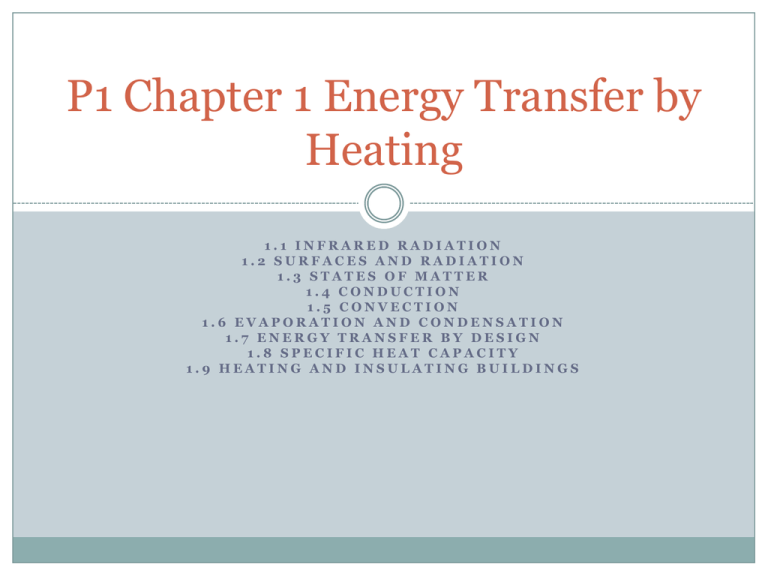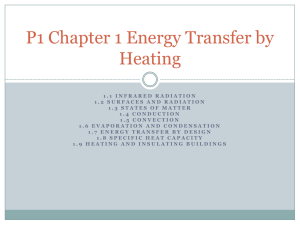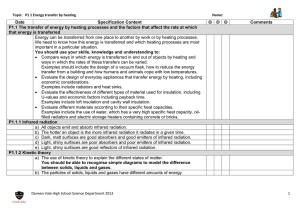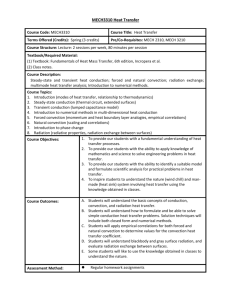P1 Chapter 2 Using Energy
advertisement

P1 Chapter 1 Energy Transfer by Heating 1.1 INFRARED RADIATION 1.2 SURFACES AND RADIATION 1.3 STATES OF MATTER 1.4 CONDUCTION 1.5 CONVECTION 1.6 EVAPORATION AND CONDENSATION 1.7 ENERGY TRANSFER BY DESIGN 1.8 SPECIFIC HEAT CAPACITY 1.9 HEATING AND INSULATING BUILDINGS 1.1 Infrared Radiation Key Points Infrared radiation is energy transfer by electromagnetic waves All objects emit infrared radiation The hotter an object is the more infrared radiation it emits in a given time Remember that transfer of energy by infrared radiation does not involve particles Q1 – How does the temperature of an object affect the rate at which it emits infrared radiation? Q2 – What is a vacuum? 1.2 Surfaces and Radiation Key Points Dark, matt surfaces emit infrared radiation more quickly than light shiny surfaces Dark, matt surfaces absorb infrared radiation more quickly than light shiny surfaces light shiny surfaces reflect more infrared radiation then dark, matt surfaces Q1 – Why are houses in hot countries often painted white? Q2 – Why are the pipes on the back of a fridge usually painted black? 1.3 States of Matter Key Points Flow, shape and volume are the properties used to describe each state of matter The particles in a solid are held next to one another, vibrating in fixed positions The particles in a liquid move about at random and are in contact with each other The particles in a gas move about randomly and are much farther apart than particles in a liquid or a solid Make sure you can describe the arrangements. Highers you need to be able to talk about the forces of attraction between the particles! 1.4 Conduction Key Points Metals are the best conductors Materials such as wool and fibreglass are good insulators. Conduction in a metal is mainly due to free electrons transferring energy inside the metal Non-metals are poor conductors because they do not contain free electrons. Know some examples of insulators and how they are used 1.5 Convection Key Points Convection is the circulation of fluid (liquid or gas) caused by heating it Convection takes place only in liquids or gases. Heating a liquid makes it less dense so it rises and causes circulation Remember that convection cannot occur in solids Make sure you can explain how convection currents are set up, in terms of changes in density when a fluid is heated Q – Why does a fluid become less dense when heated? 1.6 Evaporation and Condensation Key Points Evaporation is when a liquid turns into a gas Condensation is when a gas turns into a liquid Make sure you know the factors that affect the rate of evaporation and condensation Q1 – What effect would decreasing the surface area of a liquid have on its rate of evaporation? Q2 – What effect would decreasing the surface area of a liquid have on its rate of condensation? 1.7 Energy transfer by design Key Points The rate of energy transfer to or from an object depends on: The shape, size and type of material The materials the object is in contact with The temperature difference between the object and the surroundings Be prepared to apply your knowledge of energy transfer to different situations. These might include animal adaptations to hot or cold climates 1.8 Specific heat capacity Key Points The greater the mass of an object, the more slowly its temperature increases when it is heated The rate of temperature change in a substance when heated depends on the energy transferred to it, its mass and its specific heat capacity E=mxcxθ Q – The specific heat capacity of oil is 2100 J/kgoC. How much energy is needed to raise the temperature of 1kg of oil by 1oC? 1.9 Heating and insulating buildings Key Points The rate of energy transfer to or from our homes can be reduced U-values tell us how much energy per second passes through different materials. The lower the U-value the better the insulator Solar panels do not use fuel to heat water but they are expensive to buy and install P1 Chapter 2 Using Energy 2.1 FORMS OF ENERGY 2.2 CONSERVATION OF ENERGY 2.3 USEFUL ENERGY 2.4 ENERGY AND EFFICIENCY 2.1 Forms of energy Key Points Energy exists in different forms Energy can be transformed from one form into another When an object falls and gains speed, its gravitational potential energy decreases and its kinetic energy increases Make sure you are familiar with different forms that energy can take and know some examples of each of them! Q1 – What form of energy does a compressed spring have? Q2 – Where does the chemical energy stored in your muscles come from? 2.2 Conservation of energy Key Points Energy can be transformed from one form to another, or one place or another Energy cannot be created or destroyed Conservation of energy applies to all energy changes Conservation of energy is an extremely important idea in physics, so it will often come up in exam questions! Q1 – What energy transfers take place when you turn on a torch? Q2 – In terms of energy, what happens when you burn a fuel? 2.3Useful energy Key Points Useful energy is energy in the place we want it and the form we need it. Wasted energy is energy that is not useful energy. Useful energy and wasted energy both end up being transferred to the surroundings, which become warmer As energy spreads out, it gets more difficult to use for further energy transfers Q1 – What happens to the wasted energy from a light bulb? Q2 – Why should we talk about energy being ‘wasted’ not energy being ‘lost’. 2.4 Energy and efficiency Key Points The efficiency of an appliance = useful energy transferred by the appliance ÷ total energy supplied to the appliance (x100%) No machine can be more than 100% efficient Measures to make machines more efficient include reducing: Friction Air resistance Electrical resistance Noise due to vibrations Q1 – In a light bulb, for every 25 joules of energy that are supplied to the bulb, 5 joules are transferred into light energy. What is the efficiency of the bulb? Q2 – A machine is adjusted so that it wastes less energy because of friction. What happens to the efficiency of the machine? P1 Chapter 3 Electrical energy 3.1 ELECTRICAL APPLIANCES 3.2 ELECTRICAL POWER 3.3 USING ELECTRICAL ENERGY 3.4 COST EFFECTIVENESS MATTERS 3.1 Electrical appliances Key Points Electrical appliances can transfer useful energy Uses include heating, lighting, making objects move An electrical appliance is designed for a particular purpose and should waste as little energy as possible Make sure you are confident with your energy transfers! Q – What useful energy transfers take place in an electric drill? 3.2 Electrical power Key Points Power is the rate of transfer of energy P = E/t Efficiency = useful power out/total power in (x 100%) Practise using the equation! Q1 – How many watts are equivalent to 12 kilowatts? Q2 – An electric motor transfers 48kJ of electrical energy into kinetic energy in 2 minutes. What is the useful power output of the motor? 3.3 Using electrical energy Key Points The kilowatt-hour is energy supplied to a 1kW appliance in 1 hour E=Pxt Total cost = number of kWh x cost per kWh Remember that the kilowatt-hour is a unit of energy Q – How much electrical energy, in kWh, is transferred when a 9kW shower is used for 15 minutes? 3.4 Cost effectiveness Key Points Cost effectiveness means getting the best value for money To compare the cost effectiveness of different appliances, we need to take into account a number of different costs. Make sure you can work out the payback time for different appliances or methods of insulation! Payback time = initial cost/savings per year Q – Loft insulation costs £600 including installation. It saves £80 per year on the fuel bill. How long is the payback time?






